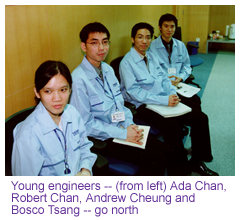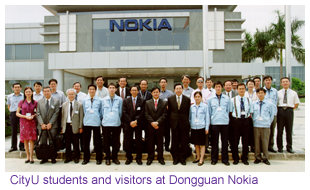"I left my heart in Dongguan" Engineering students transformed after industrial training in China
Ada Chan Hiu Kei, a third-year student in the computer engineering stream of the Department of Electronic Engineering, wishes the industrial training programme in which she is participating could be longer than it is now. "I also think that the scheme should be extended to students from other faculties as well," she says.
Ada's remarks, offered at the end of a 20-minute project presentation, were by no means casual. They summed up what she and three other students--Robert Chan, Andrew Cheung and Bosco Tsang--felt after spending close to 60 days at Dongguan Nokia Mobile Phones Co. Ltd. (DNMP) from mid-June to mid-August. In a singular demonstration of support, two dozen university professors from Hong Kong and another two dozen Nokia staff, including senior managers and mentors, were at hand to listen to the students' experiences. On the morning of 15 August, four short presentations were made at DNMP and these, in a way, could be seen as the climax of the students' affiliation with the premier mobile phone factory in Dongguan. "I came away very impressed," said Professor Roderick Wong, Dean of the Faculty of Science and Engineering (FSE), who led the group visit, at the Q&A session that followed, "not only with the depth of technical knowledge shown in these case studies but the level of articulation, maturity and confidence the students have demonstrated." The Nokia management agreed, thanking each student profusely for a job well done.
What Ada and her group experienced this summer in Dongguan was, in fact, replicated and shared by some 150 students under the Industrial Attachment Scheme (IAS), who were sent to factories scattered around the Pearl River Delta region. A few kilometres across town from Nokia, for example, some 40 students--by far the largest number in any single posting--were gaining valuable industrial experience in SAE Magnetics, a leading manufacturer of magnetic heads in hard drives. Other IAS partners that had taken CityU student engineers under their wings included major electronics manufacturers such as Philips, VTech, ASTEC and GP.
"We believe that having an understanding of China is an asset for local engineering students," said Professor Wong, "as most of Hong Kong's manufacturing industries have moved across the border" to Shenzhen, Zhuhai, Dongguan and other townships in the Pearl River Delta region. Dongguan alone, for example, a booming industrial town some 90 kilometres north of Hong Kong and less than a two-hour drive from the border, boasts 14,000 foreign-invested enterprises and joint ventures, many of which are contract manufacturers of PCBs, electronics components and accessories.
This is the second year the IAS scheme has been on offer. The number of places this time around three times as many as that of the previous year, said Professor Y C Chan, IAS coordinator. This past summer, second-year physics, materials science and manufacturing engineering students were placed, for the first time, alongside EE students in the factories. Under the scheme, the students worked on specific projects, under the supervision of their mentors, for a period of eight to nine weeks. Immersed in an industrial setting, the students functioned as regular factory employees, drew a small stipend, lived in the factory dormitories, mingled with the local staff on and off the job, and travelled back to Hong Kong for the weekends only.
Faculty members--group of around 20 academics and support staff--organized themselves into regional teams and visited the students once every two to three weeks, come heavy downpour or sweltering heat. In the final days of their IAS experience, all the students were asked to hold brief presentations before the mentors or managers in the factories where they worked. With the four Nokia presentations in the morning, however, the group from CityU only had time to listen to details of four other student projects when they visited SAE Magnetics in the afternoon of 15 August.
"When you consider the large area the scheme covers, the level of logistics involved and amount of personal care we put in," said Professor Chan, "you start to appreciate the complexity of the whole operation." The IAS, he said, is the largest and best-established scheme of its kind among local universities; some sister institutions have similar training arrangements but on a much smaller scale. The payoff for their efforts, and the driving motivation behind the contingent of FSE coordinators and supervisors who had to shuttle between Hong Kong and Shenzhen and beyond, is this: how much the students learn from this experience.
The IAS participants all thought highly of the hands-on experience because working in a real-life factory setting is different from learning in the classroom. They all worked longer hours, faced and solved real-life problems, were more prepared to give up leisure time to finish their projects and, most important of all, learned to work with others. Apart from observing at close range how their mentors worked and solved problems, and applying what they have learned at CityU, students also felt they had gained something invaluable, beyond technical skills.
"My biggest gain," said Andrew Cheung, another EE student who teamed up with Ada on the wireless LAN project at Nokia, "is a new perspective on our compatriots in China, who are so conscientious, hard-working and focused in their work." The local staff they met at Nokia--particularly those from the mainland--worked long hours, seldom complained and, most important of all, were generally more open-minded and more creative in their problem solving skills, according to Ada and Andrew.
For the industrial partners, taking novice engineers under their wings requires a heart of gold. At the SAE factory, Professor Wong, on behalf of the University, thanked the industrialists for their far-sightedness and generosity of time and effort. "You are investing in the future of Hong Kong," he said, "in our younger generation." Professor Wong said he hopes to expand the IAS to accommodate more students next year, perhaps to as many as one-third of the second-year students in FSE engineering programmes. It will depend on how the economy fares in the coming months but he believes his faculty will be able to capitalize on the close ties they have built up with their industry partners this year. Two months ago, he told a university forum on education that industrial placement should play a bigger role in an expanded, effective learning experience for CityU undergraduates, science and engineering students included. The trip to Dongguan has reinforced his conviction. "The momentum of industrial attachment has started to pick up," he said, "and it will become a significant driving force in our future curriculum reform."
As for Ada and her fellow students on the IAS, their two-month sojourn in China will surely be their most memorable and productive summer experience ever.
Staff on the Dongguan IAS trip, 14-15 August
- Professor Roderick Wong (Dean, Faculty of Science and Engineering)
- Professor P S Chung (Vice-President/Research)
- Professor C H Chan (Associate Dean, FSE) Professor Haydn Chen (Head, AP)
- Professor Y C Chan (IAS Coordinator)
- Professor P L Chu (Director, Optoelectronics Research Centre)
- Professor Michael Hung (BC & EE)
- Dr Edmund Cheung (Associate Head, MEEM)
Dongguan
- 90 km from Hong Kong
- 3,465 square kilometres in area, 6.4 million population
- 13,000 foreign-invested enterprises, mostly contract electronics manufacturers, PCB, plastics, packaging materials.
Dongguan Nokia Mobile Phones Co. Ltd.
- established in 1995
- located in Dongguan, is Nokia's second largest joint venture factory in China (the largest being in Beijing)
- new manufacturing facility on 100,000 square metre Rose Garden" site, in operation since June 2000
- maximum annual output 12 million handsets/transceivers * 100% Chinese managed
SAE Magnetics (HLK) Ltd
- established in Hong Kong in 1980, became a wholly owned subsidiary of TDK Corporation Group in 1986
one of the world's leading independent manufacturers of magnetic recording heads, head gimbals assemblies and head stack assembles for computer hard drives



